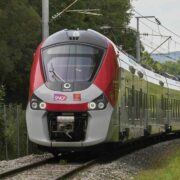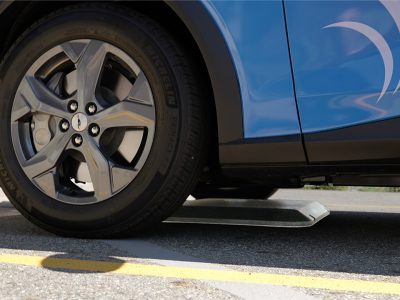I promise, I’m not turning this channel into a Tesla Cybertruck channel, but much like I’ve done in the past, I like to break technologies down to better understand how they work. And there was something about the Cybertruck that I can’t stop thinking about … well, almost everyone can’t stop thinking about … that glass. What is Tesla Armor Glass? And how is it made? And is it really that strong?
Sometime around 2016 Tesla spun up its Tesla Glass program to research and develop its own glass, which was headed up by former Apple materials engineer, Mike Pilliod, as well as Kate Kuzina.1 It makes a lot of sense why Tesla would spin up its own glass research group given how Tesla likes to use a lot of glass in their cars. Just look at the Model X windshield and roof. But they also wanted to develop something that would be more resistant to damage than your typical car window. And as we’d discover in 2017, that something would make a lot of sense in vehicles that drive a lot of miles and can’t afford downtime.
At the Tesla Semi unveiling, Elon spent a good deal of time walking through the benefits of their new Tesla Armor Glass, and why it makes so much sense for a Semi.
So what it? Tesla hasn’t released any details on their exact formulation or process that they use to make their Armor Glass, but in the Cybertruck reveal, Elon mentioned the glass being transparent metal.
Transparent metal isn’t a new thing. In fact, it’s been around for quite some time now. And if you’re a Star Trek nerd like I am, you’ll know that transparent aluminum was a thing in Star Trek IV: the Voyage Home. Stuck in the 20th century, Scotty needed to build an aquarium tank that could transport whales in their ship back to the future, but needed a lightweight and strong material to do it. He gave the transparent aluminum formula to a plexiglass company to make it for them. It’s a ridiculous plot, but as a kid that sci-fi sounding glass really stuck with me. Transparent aluminum? C’mon.
Well, little did I know that in 1986, when that Star Trek movie came out, there had already been a patent filed in 1980 for producing aluminum oxynitride, which is a transparent ceramic compound made up of aluminum, oxygen, and nitrogen.2 After combining those ingredients and compressing them into a shape, it’s baked at a very high pressure and temperature to make bricks or slabs. The result is mostly opaque, but after processing and polishing the end result is transparent-looking glass.3
The company, Surmet, which is actually located here in Massachusetts, has marketed aluminum oxynitride as ALON.4 It’s the hardest polycrystalline transparent ceramic available today and is used in military vehicles as bullet proof glass. Surmet put together a demonstration of 3.7” thick bullet proof glass vs. 1.6” thick ALON against a 50 caliber bullet.5 The results speak for themselves. The bullet was able to penetrate the bullet proof, laminated glass, while ALON stopped the bullet completely. ALON is now being considered for use in the international space station, and is also useful in space exploration. The space station windows are hit and chipped by debris in space, and NASA requires laminated glass to avoid astronauts accidentally chipping the insides of the windows. In zero gravity, tiny shards of glass floating around the space station could be very problematic. ALON would be far more resistant to those issues.
So why aren’t we seeing this used everywhere? Well, it’s far more expensive and difficult to manufacture than typical glass, which keeps prices high. The latest pricing I could find cited it costing between $10 to $15 per square inch,6 which is most likely the reason we’re not seeing it used in more places. But prices will drop as manufacturing increases, so it may have dropped lower than what I found, and Tesla may have their own formulation and process that makes mass production cheaper.
Last year, Business Insider spoke to Rosie Mottsmith, who is a staff engineer at Tesla that worked on Tesla Armor glass. The team threw everything from rocks to shredded tires and tow hitches at sheets of Tesla’s glass to make sure it met the requirements.
“Truckers are basically mechanics and handymen. If anything goes wrong, they have to fix it themselves. A lot of times people think about engineers as optimizing things, but true engineering is understanding how your product is going to be used. It doesn’t matter what happens in the lab if that doesn’t keep the trucker safe.” – Rosie Mottsmith7
While we don’t know for sure what Tesla’s formulation is for Tesla Armor Glass, it’s most likely aluminum oxynitride, which is a great candidate to achieve their goal of protecting truck drivers, and helping to keep the trucks on the road with minimal downtime. And it also makes sense why they’d want to use the same glass in the Cybertruck. I was actually a little disappointed in how they presented the features of the Cybertruck vs. how they presented the Semi. In the Semi event, they did a great job walking us through the rationale behind all of the key features of the design. Not just the what, but the why. In the Cybertruck reveal, the focus was more on the what and there was very little why. It also didn’t help that the cracked windows undercut much of the messaging, but Elon’s comment that, “It didn’t go through,” is an important point. Regardless of what caused the glass to crack when it shouldn’t have, it kept the ball from going through. And going back to Surmet’s video of the 50 caliber bullet hitting 1.6” of ALON, that cracked too … but the bullet didn’t go through.
For protecting occupants from objects hitting a car, transparent metal for windows is a huge selling point. And one that I think we’ll be seeing a lot more of in time. Just think about how durable your smartphone screen might be some day. There’s a lot of potential with this type of technology. What do you think? Do you want transparent metal for your car? Or your smartphone? And I’m curious if you like digging into some of the different aspects of what we’re seeing in Tesla’s and EVs in general? I’m so fascinated by how some of this stuff works and how it came together.
Give this video a thumbs up if you liked it, and share it with your friends because it really helps to support the channel. Check out the links in my description for some fun Tesla inspired t-shirts, and some great gear and discounts. And as always, an extra big thank you to all of my Patreon supporters. And welcome to two new Supporter + members: J Payne and Alan Johns. And there are even more folks who’ve been jumping in at the supporter level. A big, big thank you to all of you. Your support is really helping to make these videos possible. Be sure to check out my Patreon page for additional details about joining the crew.
If you haven’t already, consider subscribing and hitting the notification bell to get alerts when I post a new video. And as always, thanks so much for watching, I’ll see you in the next one.
1: http://electrek.co/2016/09/02/tesla-glass-top-secret-program/
2: http://en.wikipedia.org/wiki/Aluminium_oxynitride
3: http://www.youtube.com/watch?v=8xInI_Oq4WI http://www.youtube.com/watch?v=EI54whU8kww
4: http://surmet.com/technology/alon-optical-ceramics/index.php
5: http://www.youtube.com/watch?v=RnUszxx2pYc
6: http://reefbuilders.com/2019/05/02/transparent-aluminum/
7: http://www.businessinsider.com/tesla-engineer-shares-why-she-destroys-things-for-work-2018-2


















Comments